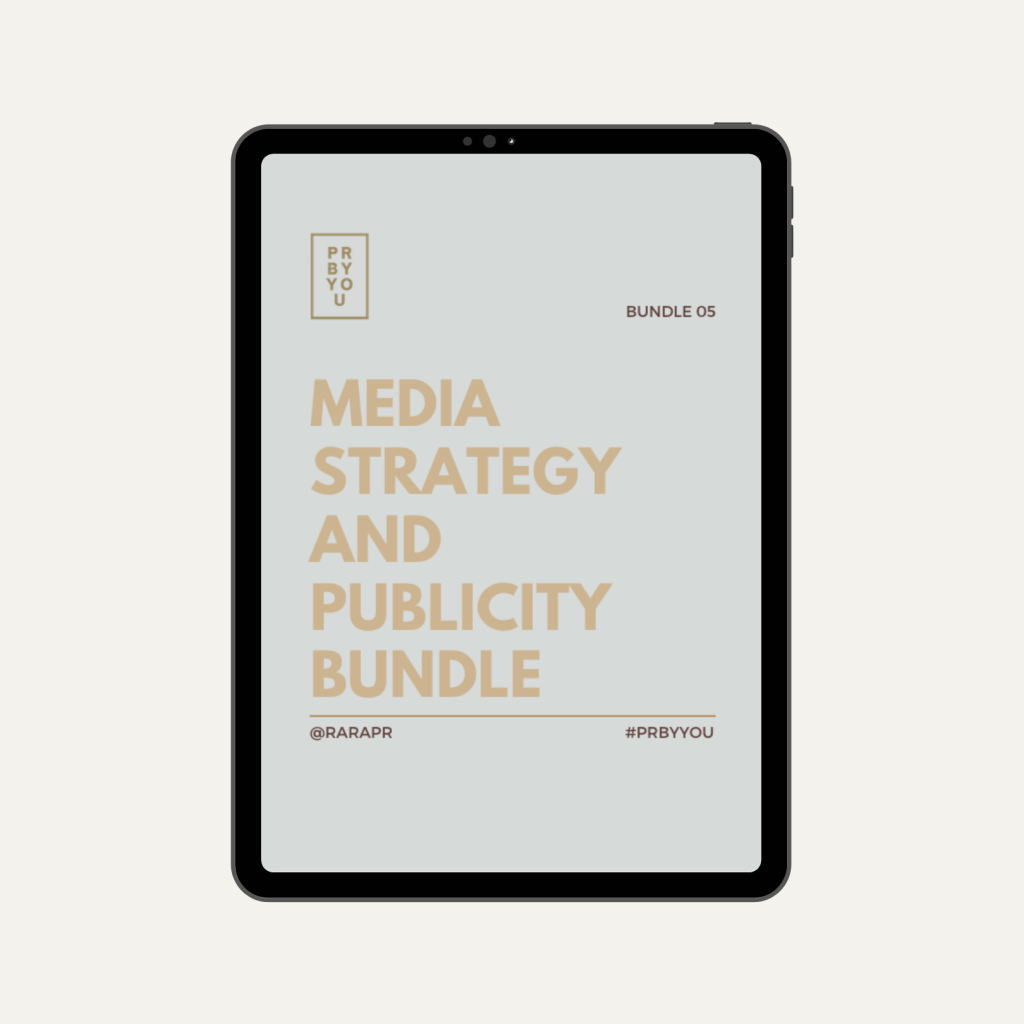How do I get PR thinking up there in the boardroom?
What if my CEO or marketing manager doesn’t respect PR?
Aside from creating a beautiful product, service, place or thing and building and online space and/or team to make it accessible, there is no resource allocation more important in a business than PR. It’s not about going out of business if you don’t invest in PR, it’s about losing market share if you don’t.
PR is what creates a brand people want to be a part of.
But because PR is not as tangible to gauge as a financial milestone it can get left on the table or worse, invested in with a whole heap of pressure to ‘dollar for dollar’ which is misinformed and misaligned with regard to how PR works.
What can happen is that senior leaders of a business responsible for giving the green light to PR budget a) don’t value it or b) know they need but don’t know how to value it and expect it function like sales or advertising (setting the PR pro up to fail).
So this blog is dedicated to helping businesses on the PR fringes understand that good PR culture is good for business.
What PR does is create narrative in and around a business that brings like-minded people together.
It’s not an investment that should ever be sitting on a profit and loss report. But we know this is tough to ask of CFOs and CEOs and what we’re really asking when we ask someone to invest in PR is this: would you mind buying something…
- you can’t see
- can’t be measured
- doesn’t have short-term guaranteed results
- doesn’t directly impact sales
- and moves slowly?
PRs pros have the very difficult task of creating something out of nothing and that’s what building a brand is all about. Finding the value that is often unseen. But it is an even more difficult task to report back on its value to appease CEOs (stakeholders or clients) who don’t really know how it works.
What PR pros need most is to work with companies that naturally value and understand PR and what it brings to a business. That way we can invest 100% of our time in getting the job done as opposed to putting a case forward for the investment once it’s in place.
The Problem
CEO doesn’t understand how PR works.
CEO expects PR to function like sales or advertising.
CEO is short-term oriented, quarter-by-quarter and PR is a long term, forever investment.
But we’re here to help; and here are some concepts you can get around (you or your CEO) to bring about significant mindset shift for business owners who are trying to make a choice about PR, its worth and how to value it. Because what we want; is for PR thinking to be up there in the boardroom exactly where it should be. We want PR to be respected for its powerful impact and contribution that it brings. Because a business with good PR culture, is a business with good PR.
Important PR Boardroom Thinking
There is no company without PR.
PR is what people say, think and perceive about your brand. There is no business without PR. It’s happening with or without you as a sum of everything you output into the world as part of your business pursuits. Businesses are doing it in one of three ways:
- Entirely unconsciously
- Randomly, or
- Thoughtfully
We recommend high-grade, thoughtful PR.
And if you can’t outsource PR yet, consider that you have PR or brand strategist in your title now. Because if you run a business then by the very nature of what you do or need to do includes PR and the PR function. This is the same for the CEO who thinks PR is not currently in their marketing mix.
The only businesses who can generally get away with ‘entirely unconsciously’ or ‘randomly’ are the ones that have a product, service or experience that resonates so deeply with fans; that the fans feel un-stoppably, compelled to tell the world about it. But in an over-crowded market where consumers are spoilt for choice, this is near-never.
PR is for thriving, not surviving.
Often when CEOs who are non-PR-cultured start thinking seriously about PR, their business is already tanking or on the death spiral. Or they have a product launching they want to generate some hype around and didn’t see the return they hoped for with advertising.
The best way to ensure a business is not just surviving but thriving however is to invest in PR that is constant. Sure it makes sense to dial up PR efforts around lead business initiatives but PR on the whole is not something any business should be dialling in at the last minute.
PR harvests the gold within a business to syndicate consistent messaging across all communication platforms and works to bring value to the businesses community always and forever.
PR builds sustained brand equity
For the companies that don’t have PR vision, sustained PR execution, or lack in PR leadership within the organisation or on the board; it diminishes brand equity. And while brand equity can’t be measured until that business goes up for sale or popped on the stock exchange; a business that has established itself as a brand people know, like, trust and want to be a part of is the kind of real estate you want to own.
Often companies start with a product or service and haphazardly evolve a brand vision and PR strategy over time, but it is the responsibility of the boardroom to begin with that the brand strategy and PR are guiding their decisions and building brand equity before its on a downward trend and can’t be saved.
The CEOs and board of directors must understand that in order to build a brand they have to invest in brand strategy and PR which creates sustained brand equity and and ultimate profitability
Spend more on PR and spend less on employee turnover and recruitment
Strong brand focused organisations have significantly better reputations, employee retention, recruitment opportunities and a more effective and efficient culture. Humans like belonging to brands because of what they stand for and what that brand says about them, their purpose and contribution in life, employees (also human) are no different. PR makes a businesses mission; vision and position consistently clear for all to see. PR not only attracts the right customer to a business; it attracts the right potential employees too. Good PR fosters good culture internally and externally to a business.
PR is a risk management function
If there’s something not working in a business the strategic PR function will step in and help fix it. PR sorts out issues management by implementing clear processes that intercept emerging issues before they become bigger problems. PR is the function that mentors spokespeople with media training and puts systems in place to respond quickly and effectively for critical situations. If a crisis emerges PR pro provides support to help diffuse the situation and minimise adverse or negative media attention. Issues, big or small are hard to reverse if good PR culture is not already in place.
PR increases customers over a lifetime of the business
PR helps you to attract better clients without PR you can be interacting with all sorts of people that were never potential clients in the first place; they walk through the door because they think you’re something and then once they get to know you and you them you realise there’s something else. They were never meant for you in the first place. What PR does is minimise the gap of uncertainty through messaging. It helps you attract the right people to your business.
It’s important to note though that PR is not directly a sales or marketing function. Marketing is usually about selling and is very short term focused, PR is a long game. PR needs investment every quarter every year. People are more drawn to a brand they recognise and they spend more on a brand they know, like and trust. This is achieved through PR.
PR contributes to change but needs the tools to do it
PR is a solution oriented, change-making function. But good PR culture and the right tools are important for the PR function to be able to work. For example. Imagine working for a retail organisation where the pursuit is to secure product placement. But the but the culture of the organisation wasn’t on-board with this concept. This could mean that the CEO doesn’t allow for enough samples to be bought to support PR. Or that the buyers managing the samples don’t make them available to PR; reducing the PR pros capacity to secure coverage and diminishing and diffusing the PR impact.
Give a customer a seat at the boardroom table
While PR has evolved from its olden day definition…‘PR fosters goodwill and a mutual and beneficial understanding between an organisation and its publics’ something like that; there is still a lot to be said for this explanation of what the PR function sets out to achieve.
For companies with CEOs who aren’t quite convinced that PR is a necessary and important investment; it might be a good idea to invite some actual customers representatives to the boardroom table and hear first hand from them. The PR pro sits between what a customer perceives about a business and what the organisation wants them to perceive and creates strategies to help to close the gap.
Summary
While CEOs and CFOs are focused on cash flow, measures of financial and tangible performance (mostly the bottom line) PR is a reputational asset in the minds of consumers. PR does bring about positive financial impact over the lifetime of a business and it does sustain prosperity. It is also pivotal to creating and sustaining shareholder and brand equity value. But often the true value and economic impact of PR is not known until it is taken away or compared with a like-business that doesn’t have good PR culture. A final note worth mentioning is this: 50 – 75 precent of the value of a business when it is being considered for purchase are its intangible assets and by this by its very nature is the concept of PR and brand.
Words by Jade Roberts
raraPR Founder and Creative Director
raraPR is above all the sum of people who together help build brands and share stories. We are present in our determination to make a positive difference to the world by representing individuals and businesses that are doing good. We are an extension of the personal stories within us, those that we exist for and those within you that need to be heard.

We welcome you to dive in and access decades of PR industry, in-house and agency experience to help you establish PR peace of mind.
PRBYYOU is a collection of interactive strategy templates and workshop facilitators that you can plug in, play with and PR your business better.
Our collection of PR, social media and brand strategy resources make it easy for you to add some PR power to all that you’re creating so that you can reach the people who need what you’ve got most.
This is accessible PR. Sustainable PR. Kind PR.


